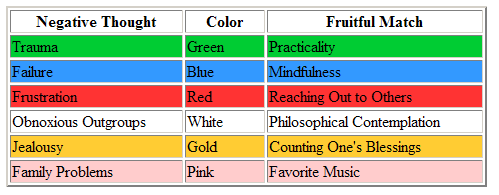 Negative thoughts have a way of inserting themselves unbidden into our minds. They reflect the unhappiness, perversity, and tragedy in our past and in the world about us. Only a Pollyanna would be ashamed to acknowledge them.
Negative thoughts have a way of inserting themselves unbidden into our minds. They reflect the unhappiness, perversity, and tragedy in our past and in the world about us. Only a Pollyanna would be ashamed to acknowledge them.
Negative thinking (rumination) does little harm as a long as it simply passes like a shadow across the otherwise sunny landscape of the mind. But negative thoughts bear a burden of emotion. They tend to plant themselves squarely in our path and grow roots. We dwell on them, sometimes for hours at a time. In certain cases this can lead to genuine depression. More often, habitual negative thinking tends to make people unhappy, pessimistic, cynical, suspicious, and morose. It also wastes precious resources of time and emotional energy. And it can lead to anxiety and depression.
Within the field of cognitive therapy, various approaches have been suggested to dissipate negative thoughts. Here is a new approach named Fruitful Matching.
Categories and Colors
Fruitful Matching includes five steps that form a framework, but it lends itself to tailoring to an individual’s situation and needs.
Step 1: Collect examples of all the kinds of negative thinking that one habitually does and sort them into categories with short, distinctive names. For instance, a person might spend quite a lot of time thinking about death and dying. So the category becomes Death. Most people can come up with at least five or six such categories.
Step 2: Tentatively pick a color that is in some way associated with the category, if only as an opposite. For instance, for the category Failures (as in embarrassing or damaging personal mistakes of the distant and recent past), one can use Blue as an indicator of the depressing feeling this negative thinking gives rise to. Bright and vivid colors work better than sombre ones.
Step 3: Think of a matching kind of thought that somehow resolves the corresponding negative category or moves one into a more hopeful or productive mode–best if it has emotional appeal. Try to find a way to match it also with the color. For instance, the initial category can be Trauma, colored Green as a sign of hope of getting beyond it. Then one can use the category Practicality to stand for finding practical ways to grow in new directions.
Step 4: Write down one’s matching categories in a table with the corresponding colors in between, then learn them by heart. One such set:
It is especially important to link the color with the initial negative thought so that one will quickly remember Fruitful Matching the next time one slips into that kind of negative thinking. So at the outset one needs to practice associating the colors with the corresponding negative thoughts–for instance, by coloring in the table. Also, one can mentally or physically paint the scene evoked by a given negative thought in the appropriate color: the sky, the buildings, the light, the shadows, the people’s faces–all become drenched in green or blue or whatever.
Step 5: During the next few days, as one engages in different kinds of negative thinking, one should recall the associated color and thereby the more benign or productive matching thought. Over time one will very likely decide to adjust the original scheme to meet one’s special needs as situation and thoughts change.
When practiced faithfully, Fruitful Matching can lead to a quantum reduction in the amount of time and energy wasted in negative thinking and boost one’s sense of personal mastery. Experience suggests that Fruitful Matching does not reduce the number of negative thoughts that pop into one’s mind, but that faithfully practicing it over many months can sharply limit the amount of time spent dwelling on such thoughts.
For a person suffering from outright depression, Fruitful Matching can serve as a handy self-help technique to lighten spirits and gain a sense of control. Or it can be used under the guidance of a counselor as an adjuvant to drug therapy or substitute for drug therapy.
Unlike many other cognitive therapies, Fruitful Matching does not require any significant changes in thinking, behavior, or personality.
As a kind of self-administered color therapy, Fruitful Matching taps into a deep, intuitive source of human physiology and psychology. It requires only a modest amount of preparation and practice with categories and colors. It can be used at almost any time or place. Fruitful Matching may prove especially effective with children, for whom coloring will seem quite natural.
Fruitful Matching has no apparent side effects, and it does not cost a penny.
(For another approach, the technique called Acknowledge and Label helps make unwanted thoughts disappear. You acknowledge the thought, then label it in three categories: 1. positive, negative, or neutral? 2. past, present, or future? and 3. about me, about someone else, or about both?
Poof. The thought disappears. Why does it work? See Moshe Bar, Mindwandering, pp 130-1. See also Promising Treatments of Severe Depression and Special Properties of the Organ for Music Therapy.)
*****
Kenneth J. Dillon is a historical and scientific researcher. See the biosketch at About Us.

